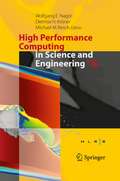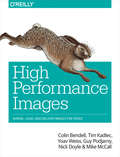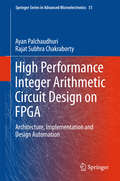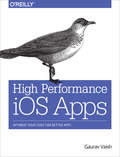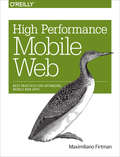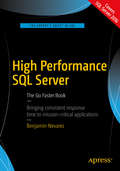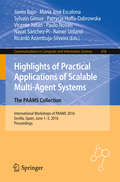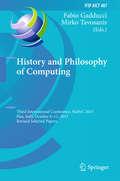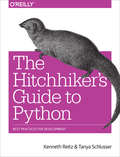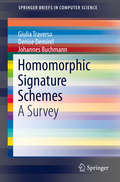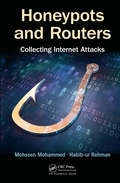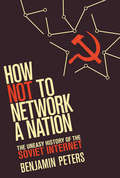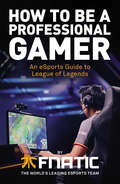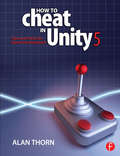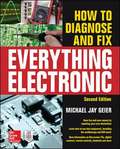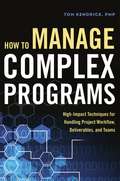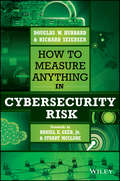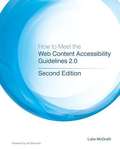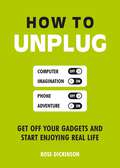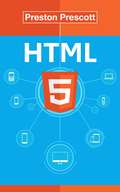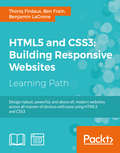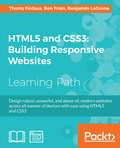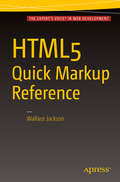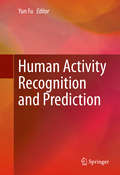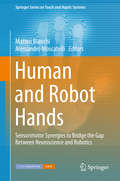- Table View
- List View
High Performance Computing in Science and Engineering ´16: Transactions of the High Performance Computing Center, Stuttgart (HLRS) 2016
by Wolfgang E. Nagel Dietmar H. Kröner Michael M. ReschThis book presents the state-of-the-art in supercomputer simulation. It includes the latest findings from leading researchers using systems from the High Performance Computing Center Stuttgart (HLRS) in 2016. The reports cover all fields of computational science and engineering ranging from CFD to computational physics and from chemistry to computer science with a special emphasis on industrially relevant applications. Presenting findings of one of Europe’s leading systems, this volume covers a wide variety of applications that deliver a high level of sustained performance.The book covers the main methods in high-performance computing. Its outstanding results in achieving the best performance for production codes are of particular interest for both scientists and engineers. The book comes with a wealth of color illustrations and tables of results.
High Performance Images: Shrink, Load, and Deliver Images for Speed
by Colin Bendell Guy Podjarny Mike Mccall Nick Doyle Tim Kadlec Yoav WeissHigh-quality images have an amazing power of attraction. Just add some stunning photos and graphics to your website or app and watch your user engagement and conversion numbers climb. It can be tricky, but with this practical guide, you’ll master the many facets of delivering high performance images on the internet—without adversely affecting site performance.You’ll learn the nuts and bolts of color theory, image formats, storage and management, operations delivery, browser and application behavior, the responsive web, and many other topics. Ideal for developers, this book also provides useful tips, tricks, and practical theory for processing and displaying powerful images that won’t slow down your online product.Explore digital image theory and the different formats availableDive into JPEGs, SVG and vector images, lossless compression, and other formatsUse techniques for downloading and rendering images in a browser, and for loading images on mobile devices and cellular networksExamine specific rendering techniques, such as lazy loading, image processing, image consolidation, and responsive imagesTake responsive images to the next level by using content negotiation between browser and server with the Client Hints HTTP standardLearn how to operationalize your image workflowContributors include Colin Bendell, Tim Kadlec, Yoav Weiss, Guy Podjarny, Nick Doyle, and Mike McCall from Akamai Technologies.
High Performance Integer Arithmetic Circuit Design on FPGA
by Ayan Palchaudhuri Rajat Subhra ChakrabortyThis book describes the optimized implementations of several arithmetic datapath, controlpath and pseudorandom sequence generator circuits for realization of high performance arithmetic circuits targeted towards a specific family of the high-end Field Programmable Gate Arrays (FPGAs). It explores regular, modular, cascadable and bit-sliced architectures of these circuits, by directly instantiating the target FPGA-specific primitives in the HDL. Every proposed architecture is justified with detailed mathematical analyses. Simultaneously, constrained placement of the circuit building blocks is performed, by placing the logically related hardware primitives in close proximity to one another by supplying relevant placement constraints in the Xilinx proprietary "User Constraints File". The book covers the implementation of a GUI-based CAD tool named FlexiCore integrated with the Xilinx Integrated Software Environment (ISE) for design automation of platform-specific high-performance arithmetic circuits from user-level specifications. This tool has been used to implement the proposed circuits, as well as hardware implementations of integer arithmetic algorithms where several of the proposed circuits are used as building blocks. Implementation results demonstrate higher performance and superior operand-width scalability for the proposed circuits, with respect to implementations derived through other existing approaches. This book will prove useful to researchers, students and professionals engaged in the domain of FPGA circuit optimization and implementation.
High Performance iOS Apps: Optimize Your Code for Better Apps
by Gaurav VaishReady to build mobile apps that out-perform the rest? If you're an iOS developer with app-building experience, this practical guide provides tips and best practices to help you solve many common performance issues. You'll learn how to design and optimize iOS apps that deliver a smooth experience even when the network is poor and memory is low.Today's picky users want fast and responsive apps that don't hog resources. In this book, author Gaurav Vaish demonstrates methods for writing optimal code from an engineering perspective, using reusable Objective-C code that you can use right away. Up your game and create high-performance native iOS apps that truly stand out from the crowd.Measure key performance indicators--attributes that constitute and affect app performanceWrite efficient apps by minimizing memory and power consumption, and explore options for using available CPU coresOptimize your app's lifecycle and UI, as well as its networking, data sharing, and security featuresLearn about application testing, debugging and analysis tools, and monitoring your app in the wildCollect data from real users to analyze app usage, identify bottlenecks, and provide fixesUse iOS 9 upgrades to improve your app's performance
High Performance Mobile Web: Best Practices for Optimizing Mobile Web Apps
by Maximiliano FirtmanOptimize the performance of your mobile websites and webapps to the extreme. With this hands-on book, veteran mobile and web developer Maximiliano Firtman demonstrates which aspects of your site or app slow down the user's experience, and what you can do to achieve lightning-fast performance. There's much at stake: if you want to boost your app's conversion rate, then tackling performance issues is the best way to start.Learn tools and techniques for working with responsive web design, images, the network layer, and many other ingredients--plus the metrics to check your progress. Ideal for web developers and web designers with HTML, CSS, JavaScript, and HTTP experience, this is your guide to superior mobile web performance.You'll dive into:Emulators, simulators, and other tools for measuring performanceBasic web performance concepts, including metrics, charts, and goalsHow to get real data from mobile browsers on your real networksAPIs and specs for measuring, tracking and improving web performanceInsights and tricks for optimizing the first view experienceWays to optimize post-loading experiences and future visitsResponsive web design and its performance challengesTips for extreme performance to achieve best conversion ratesHow to work with web views inside native apps
High Performance SQL Server
by Benjamin NevarezDesign and configure SQL Server instances and databases in support of high-throughput applications that are mission-critical and provide consistent response times in the face of variations in user numbers and query volumes. Learn to configure SQL Server and design your databases to support a given instance and workload. You'll learn advanced configuration options, in-memory technologies, storage and disk configuration, and more, all toward enabling your desired application performance and throughput. Configuration doesn't stop with implementation. Workloads change over time, and other impediments can arise to thwart desired performance. High Performance SQL Server covers monitoring and troubleshooting to aid in detecting and fixing production performance problems and minimizing application outages. You'll learn a variety of tools, ranging from the traditional wait analysis methodology to the new query store, and you'll learn how improving performance is really an iterative process. High Performance SQL Server is based on SQL Server 2016, although most of its content can be applied to prior versions of the product. This book is an excellent complement to performance tuning books focusing on SQL queries, and provides the other half of what you need to know by focusing on configuring the instances on which mission-critical queries are executed. Covers SQL Server instance-configuration for optimal performance Helps in implementing SQL Server in-memory technologies Provides guidance toward monitoring and ongoing diagnostics What You Will Learn Understand SQL Server's database engine and how it processes queries Configure instances in support of high-throughput applications Provide consistent response times to varying user numbers and query volumes Design databases for high-throughput applications with focus on performance Record performance baselines and monitor SQL Server instances against them Troubleshot and fix performance problems Who This Book Is For SQL Server database administrators, developers, and data architects. The book is also of use to system administrators who are managing and are responsible for the physical servers on which SQL Server instances are run.
Highlights of Practical Applications of Scalable Multi-Agent Systems. The PAAMS Collection
by Javier Bajo María José Escalona Sylvain Giroux Patrycja Hoffa-Dąbrowska Vicente Julián Paulo Novais Nayat Sánchez-Pi Rainer Unland Ricardo Azambuja-SilveiraThis book constitutes the refereed proceedings of the seven workshops co-located with the 14th International Conference on Practical Applications of Agents and Multi-Agent Systems, PAAMS 2016, held in Sevilla, Spain, in June 2016. The 37 full papers presented were carefully reviewed and selected from 77 submissions. The volume presents the papers that have been accepted for the following workshops: Workshop on Agents and Multi-Agent Systems for AAL and e-Health; Workshop on Agent-Based Solutions for Manufacturing and Supply Chain; Workshop on MAS for Complex Networks and Social Computation; Workshop on Decision Making in Dynamic Information Environments; Workshop on Intelligent Systems for Context-based Information Fusion; Workshop on Multi-Agent based Applications for Smart Grids and Sustainable Energy Systems; Workshop on Multiagent System based Learning Environments.
History and Philosophy of Computing
by Fabio Gadducci Mirko TavosanisThis volume constitutes the refereed post-conference proceedings of the Third International Conference on the History and Philosophy of Computing, held in Pisa, Italy in October 2015. The 18 full papers included in this volume were carefully reviewed and selected from the 30 papers presented at the conference. They cover topics ranging from the world history of computing to the role of computing in the humanities and the arts.
The Hitchhiker's Guide to Python: Best Practices for Development
by Tanya Schlusser Kenneth ReitzThe Hitchhiker's Guide to Python takes the journeyman Pythonista to true expertise. More than any other language, Python was created with the philosophy of simplicity and parsimony. Now 25 years old, Python has become the primary or secondary language (after SQL) for many business users. With popularity comes diversity--and possibly dilution.This guide, collaboratively written by over a hundred members of the Python community, describes best practices currently used by package and application developers. Unlike other books for this audience, The Hitchhiker's Guide is light on reusable code and heavier on design philosophy, directing the reader to excellent sources that already exist.
Homomorphic Signature Schemes
by Giulia Traverso Denise Demirel Johannes BuchmannHomomorphic signature schemes are an important primitive for many applications and since their introduction numerous solutions have been presented. Thus, in this work we provide the first exhaustive, complete, and up-to-date survey about the state of the art of homomorphic signature schemes. First, the general framework where homomorphic signatures are defined is described and it is shown how the currently available types of homomorphic signatures can then be derived from such a framework. In addition, this work also presents a description of each of the schemes presented so far together with the properties it provides. Furthermore, three use cases, electronic voting, smart grids, and electronic health records, where homomorphic signature schemes can be employed are described. For each of these applications the requirements that a homomorphic signature scheme should fulfill are defined and the suitable schemes already available are listed. This also highlights the shortcomings of current solutions. Thus, this work concludes with several ideas for future research in the direction of homomorphic signature schemes.
Honeypots and Routers: Collecting Internet Attacks
by Mohssen Mohammed Habib-ur RehmanAs the number of Internet-based consumer transactions continues to rise, the need to protect these transactions against hacking becomes more and more critical. An effective approach to securing information on the Internet is to analyze the signature of attacks in order to build a defensive strategy. This book explains how to accomplish this using h
How Not to Network a Nation: The Uneasy History of the Soviet Internet (Information Policy)
by Benjamin PetersHow, despite thirty years of effort, Soviet attempts to build a national computer network were undone by socialists who seemed to behave like capitalists.Between 1959 and 1989, Soviet scientists and officials made numerous attempts to network their nation—to construct a nationwide computer network. None of these attempts succeeded, and the enterprise had been abandoned by the time the Soviet Union fell apart. Meanwhile, ARPANET, the American precursor to the Internet, went online in 1969. Why did the Soviet network, with top-level scientists and patriotic incentives, fail while the American network succeeded? In How Not to Network a Nation, Benjamin Peters reverses the usual cold war dualities and argues that the American ARPANET took shape thanks to well-managed state subsidies and collaborative research environments and the Soviet network projects stumbled because of unregulated competition among self-interested institutions, bureaucrats, and others. The capitalists behaved like socialists while the socialists behaved like capitalists. After examining the midcentury rise of cybernetics, the science of self-governing systems, and the emergence in the Soviet Union of economic cybernetics, Peters complicates this uneasy role reversal while chronicling the various Soviet attempts to build a “unified information network.” Drawing on previously unknown archival and historical materials, he focuses on the final, and most ambitious of these projects, the All-State Automated System of Management (OGAS), and its principal promoter, Viktor M. Glushkov. Peters describes the rise and fall of OGAS—its theoretical and practical reach, its vision of a national economy managed by network, the bureaucratic obstacles it encountered, and the institutional stalemate that killed it. Finally, he considers the implications of the Soviet experience for today's networked world.
How To Be a Professional Gamer: An eSports Guide to League of Legends
by Fnatic Kikis YellOwStar Spirit Febiven Rekkles Mike DiverIt’s time to become a Legend.Watched by millions and contested by the best professional gamers in the world, League of Legends is more than a game. Since the very beginnning of eSports, Fnatic have been competing at the highest level. In 2011, they won the World Championships and in 2015 they achieved the impossible: an entire regular season undefeated. In How to be a Professional Gamer, they take you inside the elite world of the sport, and into the world of competitive gaming. Sharing their knowledge, expertise, and strategies, it’s only a matter of time before you’re a world champion, too.Including tips on game strategy, teamwork and mental strength, How to be a Professional Gamer is both a guide for how to improve as a regular gamer, and the story of Fnatic and how they’ve conquered the world of eSports.Are you ready?
How to Cheat in Unity 5: Tips and Tricks for Game Development
by Alan ThornLooking to become more efficient using Unity? <P><P>How to Cheat in Unity 5 takes a no-nonsense approach to help you achieve fast and effective results with Unity 5. Geared towards the intermediate user, HTC in Unity 5 provides content beyond what an introductory book offers, and allows you to work more quickly and powerfully in Unity. Packed full with easy-to-follow methods to get the most from Unity, this book explores time-saving features for interface customization and scene management, along with productivity-enhancing ways to work with rendering and optimization. In addition, this book features a companion website at www.alanthorn.net, where you can download the book’s companion files and also watch bonus tutorial video content. <P><P>Learn bite-sized tips and tricks for effective Unity workflows <P><P>Become a more powerful Unity user through interface customization <P><P>Enhance your productivity with rendering tricks, better scene organization and more <P><P>Better understand Unity asset and import workflows <P><P>Learn techniques to save you time and money during development
How To Diagnose And Fix Everything Electronic
by Michael Jay GeierRepair all kinds of electrical products, from modern digital gadgets to analog antiques, with help from this updated book. How to Diagnose and Fix Everything Electronic, Second Edition, offers expert insights, case studies, and step-by-step instruction from a lifelong electronics guru. Discover how to assemble your workbench, use the latest test equipment, zero in on and replace dead components, and handle reassembly. Instructions for specific devices, including stereos, MP3 players, digital cameras, flat-panel TVs, laptops, headsets, and mobile devices are also included in this do-it-yourself guide. Choose the proper tools and set up your workbench Ensure personal safety and use proper eye and ear protection Understand how electrical components work and why they fail Perform preliminary diagnoses based on symptoms Use test equipment, including digital multimeters, ESR meters, frequency counters, and oscilloscopes Interpret block, schematic, and pictorial diagrams Disassemble products and identify sections Analyze circuits, locate faults, and replace dead parts Re-establish connections and reassemble devices
How to Manage Complex Programs: High-Impact Techniques for Handling Project Workflow, Deliverables, and Teams
by Tom KendrickProgram manager--it's one of the most challenging jobs you can have. Overseeing and coordinating multiple project teams and thousands of activities may seem a Herculean task, but it's easier with the right tools in hand.Successful program management begins with a good command of project management processes, but these are never sufficient. Once a program exceeds a certain scale, project processes become unwieldy. To see a program successfully through to completion, you must break the work down into simpler, smaller pieces and organize it into interdependent tasks.Complete with diagrams, graphs, and real-life examples, How to Manage Complex Programs explains the ins and outs of program management and provides concrete and effective techniques for structuring deliverables, workflow, and staffing. You'll learn to:Decompose complex deliverables into manageable chunksDevelop coherent plans for component projectsHandle cross-project dependenciesOrganize program staff and project leaders into a high-performing teamAnd moreYes, program management is challenging. But with these proven strategies, it can also be highly rewarding--for you and for your organization.
How to Measure Anything in Cybersecurity Risk
by Richard Seiersen Daniel E. Geer Jr. Stuart Mcclure Douglas W. HubbardA ground shaking exposé on the failure of popular cyber risk management methods How to Measure Anything in Cybersecurity Risk exposes the shortcomings of current "risk management" practices, and offers a series of improvement techniques that help you fill the holes and ramp up security. In his bestselling book How to Measure Anything, author Douglas W. Hubbard opened the business world's eyes to the critical need for better measurement. This book expands upon that premise and draws from The Failure of Risk Management to sound the alarm in the cybersecurity realm. Some of the field's premier risk management approaches actually create more risk than they mitigate, and questionable methods have been duplicated across industries and embedded in the products accepted as gospel. This book sheds light on these blatant risks, and provides alternate techniques that can help improve your current situation. You'll also learn which approaches are too risky to save, and are actually more damaging than a total lack of any security. Dangerous risk management methods abound; there is no industry more critically in need of solutions than cybersecurity. This book provides solutions where they exist, and advises when to change tracks entirely. Discover the shortcomings of cybersecurity's "best practices" Learn which risk management approaches actually create risk Improve your current practices with practical alterations Learn which methods are beyond saving, and worse than doing nothing Insightful and enlightening, this book will inspire a closer examination of your company's own risk management practices in the context of cybersecurity. The end goal is airtight data protection, so finding cracks in the vault is a positive thing--as long as you get there before the bad guys do. How to Measure Anything in Cybersecurity Risk is your guide to more robust protection through better quantitative processes, approaches, and techniques.
How To Meet The Web Content Accessibility Guidelines 2. 0
by Luke McGrathLearn 'How to Meet the Web Content Accessibility Guidelines 2.0′ I wrote this book to help you learn how to meet these important guidelines. You'll find out how an accessible website can still be beautiful, successful and fun for your users. Taking each guideline in turn, you'll learn why it's important for users, the best way to comply, plus any tips and tricks to make your life easier. Web accessibility is an in-demand and growing skill for developers, and this book is designed to get you started, fast. "Of all the books and documents that discuss why and how to make websites more accessible, this is the one I use and recommend more than any other." - Martin Ansdell-Smith
How to Unplug: Get Off Your Gadgets and Start Enjoying Real Life
by Ross DickinsonDo you feel like a slave to your smartphone? If it seems like you’ve become a junkie to modern technology, this sanity-saving collection of ideas will motivate you to get more out of life. Full of suggestions to help you unwind and reconnect with the world around you, How to Unplug is a handbook for refreshing yourself in the digital age.
HTML 5
by Preston Prescott Eleonora BaronScoprite le novità di HTML Grazie a questo libro scoprirete le basi di HTML 5 e come utilizzarlo. Se conoscete già le precedenti versioni di HTML, in special modo HTML 4, imparare a usare HTML 5 sarà un gioco da ragazzi. HTML 5 è la versione più recente dell' Hypertext Markup Language, tuttavia ha mantenuto svariate caratteristiche di HTML 4 e persino di XHTML. Cosa scoprirete leggendo questo volume? *Le differenze tra HTML 4 e 5 *La struttura dei documenti HTML 5 *Come gestire titoli, paragrafi, elenchi, tabelle e form *Come gestire i link e le immagini *Come incorporare contenuti complessi, citazioni, video e audio *Come formattare le vostre pagine web nel modo più accattivante ed efficace Volete saperne di più? Scaricate subito la vostra copia!
HTML5 and CSS3: Building Responsive Websites
by Thoriq Firdaus Ben Frain Benjamin LagroneDesign robust, powerful, and above all, modern websites across all manner of devices with ease using HTML5 and CSS3 About This Book * Use Responsive Grid System, Bootstrap, and Foundation frameworks for responsive web design * Learn how to use the latest features of CSS including custom fonts, nth-child selectors (and some CSS4 selectors), CSS custom properties (variables), and CSS calc * Make a mobile website using jQuery mobile and mobile-first design Who This Book Is For This course is for web developers who are familiar with HTML and CSS but want to understand the essentials of responsive web design. It is for those developers who are willing to seek innovative techniques that deliver fast, intuitive interfacing with the latest mobile Internet devices. What You Will Learn * Build a semantic website structure with HTML5 elements * Use Bower to organize website dependencies * Make responsive media that is optimized for the specific device on which it's displayed, allowing images, videos, and other elements be fully appreciated * Make typography that's fluidly responsive, so it's easy to read on all devices--no more hard-to-see text on a tiny mobile screen * Get to know techniques for server-side and client-side media deployment, providing platforms that are scaled for any device that requests them In Detail Responsive web design is an explosive area of growth in modern web development due to the huge volume of different device sizes and resolutions that are now commercially available. The Internet is going mobile. Desktop-only websites just aren't good enough anymore. With mobile internet usage still rising and tablets changing internet consumption habits, you need to know how to build websites that will just "work," regardless of the devices used to access them. This Learning Path course explains all the key approaches necessary to create and maintain a modern responsive design using HTML5 and CSS3. Our first module is a step-by-step introduction to ease you into the responsive world, where you will learn to build engaging websites. With coverage of Responsive Grid System, Bootstrap, and Foundation, you will discover three of the most robust frameworks in responsive web design. Next, you'll learn to create a cool blog page, a beautiful portfolio site, and a crisp professional business site and make them all totally responsive. Packed with examples and a thorough explanation of modern techniques and syntax, the second module provides a comprehensive resource for all things "responsive." You'll explore the most up-to-date techniques and tools needed to build great responsive designs, ensuring that your projects won't just be built "right" for today, but in the future too. The last and the final module is your guide to obtaining full access to next generation devices and browser technology. Create responsive applications that make snappy connections for mobile browsers and give your website the latest design and development advantages to reach mobile devices. At the end of this course, you will learn to get and use all the tools you need to build and test your responsive web project performance and take your website to the next level. This Learning Path combines some of the best that Packt has to offer in one complete, curated package. It includes content from the following Packt products: * Responsive Web Design by Example: Beginner's Guide - Second Edition by Thoriq Firdaus * Responsive Web Design with HTML5 and CSS3 - Second Edition by Ben Frain * HTML5 and CSS3 Responsive Web Design Cookbook by Benjamin LaGrone Style and approach This Learning Path course provides a simplistic and easy way to build powerful, engaging, responsive, and future proof websites across devices using HTML5 and CSS3 to meet the demands of the modern web user.
HTML5 and CSS3: Building Responsive Websites
by Thoriq Firdaus Ben Frain Benjamin LaGrone<P><P>About This Book <P><P>Use Responsive Grid System, Bootstrap, and Foundation frameworks for responsive web design <P><P>Learn how to use the latest features of CSS including custom fonts, nth-child selectors (and some CSS4 selectors), CSS custom properties (variables), and CSS calc <P><P>Make a mobile website using jQuery mobile and mobile-first design <P><P>Who This Book Is For <P><P>This course is for web developers who are familiar with HTML and CSS but want to understand the essentials of responsive web design. It is for those developers who are willing to seek innovative techniques that deliver fast, intuitive interfacing with the latest mobile Internet devices. <P><P>What You Will Learn <P><P>Build a semantic website structure with HTML5 elements <P><P>Use Bower to organize website dependencies <P><P>Make responsive media that is optimized for the specific device on which it's displayed, allowing images, videos, and other elements be fully appreciated <P><P>Make typography that's fluidly responsive, so it's easy to read on all devices—no more hard-to-see text on a tiny mobile screen <P><P>Get to know techniques for server-side and client-side media deployment, providing platforms that are scaled for any device that requests them <P><P>In Detail <P><P>Responsive web design is an explosive area of growth in modern web development due to the huge volume of different device sizes and resolutions that are now commercially available. The Internet is going mobile. Desktop-only websites just aren't good enough anymore. With mobile internet usage still rising and tablets changing internet consumption habits, you need to know how to build websites that will just “work,” regardless of the devices used to access them. This Learning Path course explains all the key approaches necessary to create and maintain a modern responsive design using HTML5 and CSS3. <P><P>Our first module is a step-by-step introduction to ease you into the responsive world, where you will learn to build engaging websites. With coverage of Responsive Grid System, Bootstrap, and Foundation, you will discover three of the most robust frameworks in responsive web design. Next, you'll learn to create a cool blog page, a beautiful portfolio site, and a crisp professional business site and make them all totally responsive. <P><P>Packed with examples and a thorough explanation of modern techniques and syntax, the second module provides a comprehensive resource for all things “responsive.” You'll explore the most up-to-date techniques and tools needed to build great responsive designs, ensuring that your projects won't just be built “right” for today, but in the future too. <P><P>The last and the final module is your guide to obtaining full access to next generation devices and browser technology. Create responsive applications that make snappy connections for mobile browsers and give your website the latest design and development advantages to reach mobile devices. At the end of this course, you will learn to get and use all the tools you need to build and test your responsive web project performance and take your website to the next level. <P><P>This Learning Path combines some of the best that Packt has to offer in one complete, curated package. It includes content from the following Packt products: <P><P>Responsive Web Design by Example: Beginner's Guide - Second Edition by Thoriq Firdaus <P><P>Responsive Web Design with HTML5 and CSS3 - Second Edition by Ben Frain <P><P>HTML5 and CSS3 Responsive Web Design Cookbook by Benjamin LaGrone <P><P>Style and approach <P><P>This Learning Path course provides a simplistic and easy way to build powerful, engaging, responsive, and future proof websites across devices using HTML5 and CSS3 to meet the demands of the modern web user.
HTML5 Quick Markup Reference
by Wallace JacksonHTML5 Quick Mark-Up Reference is a handbook covering tags and parameters central to HTML5 mark-up using the NetBeans 8. 1 open source HTML5 IDE software package. The book covers the tags used in the HTML5 mark-up language, logically organized by topical chapters, and getting more advanced as chapters progress, covering new media tags and file formats are best for use with HTML5, as well as key factors regarding the data footprint optimization work process, in-lining . CSS and . JS files, and why data footprint optimization is important. What you'll learn The Tags supported in HTML5 What Comprises an HTML5 Content Production Workflow Concepts and Principles behind HTML5 Content Production How to Install and Utilize 64-bit Inkscape 0. 91 for Windows, Mac OSX and Linux Concepts behind Spline Curves, Strokes, Fills, Patterns and Rendering Digital Illustration Data Formats and Data Footprint Optimization Who this book is for Primary: Website Developers, Flash Developers, User Interface Designers, HTML5 OS Application Developers, HTML5 e-Learning Content Creators, HTML5 eBook Authors, HTML5 OS iTV Programmers Secondary: Blackberry Developers, Windows Developers, Android Developers, iOS Developers, Multimedia Producers, Rich Internet Application (RIA) Programmers, HTML5 Game Designers, Teachers, Educators.
Human Activity Recognition and Prediction
by Yun FuThis book provides a unique view of human activity recognition, especially fine-grained human activity structure learning, human-interaction recognition, RGB-D data based action recognition, temporal decomposition, and causality learning in unconstrained human activity videos. The techniques discussed give readers tools that provide a significant improvement over existing methodologies of video content understanding by taking advantage of activity recognition. It links multiple popular research fields in computer vision, machine learning, human-centered computing, human-computer interaction, image classification, and pattern recognition. In addition, the book includes several key chapters covering multiple emerging topics in the field. Contributed by top experts and practitioners, the chapters present key topics from different angles and blend both methodology and application, composing a solid overview of the human activity recognition techniques.
Human and Robot Hands
by Matteo Bianchi Alessandro MoscatelliThis booklooks at the common problems both human and robotic hands encounter when controllingthe large number of joints, actuators and sensors required to efficientlyperform motor tasks such as object exploration, manipulation and grasping. The authorsadopt an integrated approach to explore the control of the hand based onsensorimotor synergies that can be applied in both neuroscience androbotics. Hand synergies are based on goal-directed, combined muscle andkinematic activation leading to a reduction of the dimensionality of the motorand sensory space, presenting a highly effective solution for the fast and simplifieddesign of artificial systems. Presented intwo parts, the first part, Neuroscience, provides the theoretical andexperimental foundations to describe the synergistic organization of the humanhand. The second part, Robotics, Models and Sensing Tools, exploits theframework of hand synergies to better control and design robotic hands andhaptic/sensing systems/tools, using a reduced number of control inputs/sensors,with the goal of pushing their effectiveness close to the natural one. Human andRobot Hands provides a valuable reference for students, researchers anddesigners who are interested in the study and design of the artificial hand.
